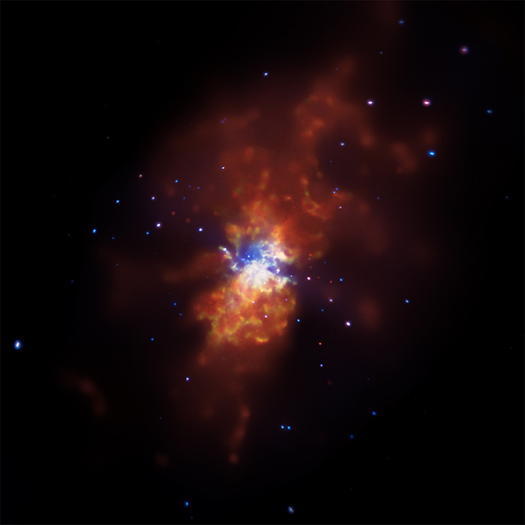"All the Data that FITS"
This week marks a milestone in the openFITS collection as we've nearly doubled the amount of data offered up for curious minds to explore and create their own images. We now offer a collection of 17 data sets covering supernova remnants, galaxies, neutron stars, pulsars, and the supermassive black hole at the center of our very own galaxy, the Milky Way. Additionally, we've updated the openFITS overview and tutorials to reflect changes in the newest version of GIMP (v2.8), our choice of image processing platform for this project. GIMP v2.8 is now available as a native application on Mac OS X and offers some exciting new features as well as laying the groundwork for very exciting developments to come.
To mark this occasion, I thought it would be interesting to choose one of our images and provide some background context from the image processor's perspective - to add that human element to something so far removed from humanity. For this entry, I'm going with our beautifully rich, deep X-ray image of M82 - the "Cigar Galaxy". M82 is one of those "poster galaxies" for the importance of exploring our universe in many wavelengths. Looking at our X-ray image, you may wonder why it's called the "Cigar Galaxy" - well, have a look at the optical image and you'll see why. M82 is known as a starburst galaxy filled with intense regions of active star formation. These active regions, seen as bright spots in optical light, tend to produce copious amounts of X-ray light, as is obvious in our Chandra image. The combined winds from many supernova explosions drive the hot X-ray gas extending above and below the plane of the galaxy, none of which is seen in the optical image alone.
This was a particularly difficult image to process given the large amount of data collected (over 5 days worth) and the desire to accurately represent the wildly varying intensities of X-ray light, from the highly energetic and bright core to the diffuse clouds of X-ray gas. I remember when my good friend Dr. Roy Kilgard, the principal investigator on the M82 project, sent me an email, giddy with excitement over the new bounty of X-ray data he was getting on this object. Our previous version of this image was made with about 13 hours worth of data, so this was going to be a big improvement. Incidentally, one of the things I love most about this job is the level of excitement exhibited by the scientists involved in these research projects. They truly love what they're doing, and it taps into a childlike sense of wonder and curiosity in all of us. It's an honor to bring their data to life through image processing!
With all of the data pouring in, I had many processing options, as well as some difficult decisions to make in terms of how to best represent the data. In a data set as rich as M82, one has the option of splitting up the X-ray spectrum into many component parts, isolating different elements radiating at X-ray energies. Anyone who attempts the M82 openFITS image will see that we've provided 7 different energy bands, potentially leading to a 7 color image! Many attempts at incorporating all of the color bands into a single image resulted in muddy colors or a completely over-saturated core of the galaxy. I was pursuing other approaches, and it just so happened that at the time I was processing this image, I was also learning the ropes of the PixInsight image processing platform.
PixInsight was developed from the ground up by astronomers for astronomers and has a very active and engaged user community always willing to share useful tips and lessons. It was during this time that I learned about a particularly useful tool within PixInsight called PixelMath. PixelMath allows you to mathematically combine any number of desired images into a single Red, Green, and Blue image. There are other ways to do this of course, but this approach seemed very intuitive to me. I devised a formula that combined the 7 bands of data into 3 bands of RGB color while preserving the structures and intensities in the individual bands without over-saturating the core, and clearly distinguishing the energy-dependent features of this amazing image. Overlaying a carefully smoothed broad-band X-ray image (using GREYCstoration) led to the final version of the image that you see today.
It seems that with astronomical image processing, each project brings its own unique set of circumstances to the table, which requires new and different approaches. While there are many techniques that can be applied to various images, there's seldom a one-size-fits-all approach to these images. That's what makes this work so interesting; there's always a new challenge waiting around the corner. So take that bit of insight, and go download some FITS files and get to work figuring out your approach to astronomical image processing.
Joe DePasquale
Science Imager
Category:
- Log in to post comments

